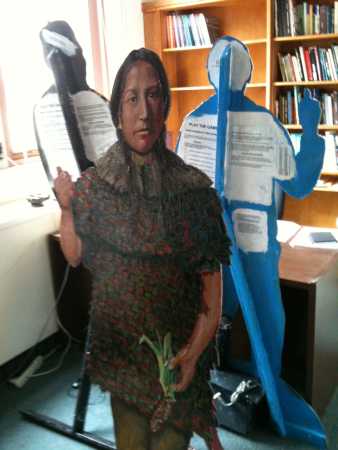"Take
care of the earth and she will take care of you."
The animated image marks the current location Clicking on it or the balloons will display the time. The black arrow marks the exact location. |
||
| Lenni
Lenape
"Carry Me Back" at the "Games Show NYC" in the Macy Gallery at the Teacher's College of Columbia University |
||
The
Hitchhiker
of a Lenni Lenape woman is constructed of
light-weight reinforced plywood held upright by a collapsible
prop. Its current location - within an hour- is
displayed on the map above.
Clicking on the animated figure will
display the time the location was reported. A note on the
sculpture's back
requests passers-by to become Players by picking
up the Lenni Lenape and taking her on an adventure.
If
they do, the note offers each of the five players that take the Lenni
Lenape
Hitchhiker on the best adventures a 1/7th share in the
sculpture.
Here
are some places she might like to visit:
 |
||
|
|
||
| In
his depiction of a Lenni Lenape woman,
artist Jim Pallas was inspired by the description that Giovanni da
Verrazano,
the Italian explorer, wrote of the people he met in 1524.
He said, "These people are the most beautiful and have the
most civil
customs that we have found on this voyage. They are taller than we are,
they are a bronze color, some tending more towards whiteness, others to
a tawny color; the face is clean-cut, the hair is long, and their
manner is sweet and gentle, very like that of the ancients. They have
all the proportions belonging to any well built men. Their women are
just as shapely and beautiful; very gracious, of attractive manner and
pleasant appearance." The clothing of the Lenape was simple.....Women had knee or calf length wrap around skirts and wore fur robes in winter, or a beautiful mantle made from turkey feathers. Ornaments of bone, shell and wampum were sometimes worn as necklaces, or on wrists and ankles The Lenape
(pronounced /ˈlɛnəpiː/or/ləˈnɑːpi/)
are a group of several organized bands of Native American people with
shared cultural and linguistic characteristics. Their name for
themselves sometimes spelled Lennape or Lenapi, means "the
people."
They are also known as the Lenni Lenape (the "true
people") or as the Delaware Indians. English
settlers named the Delaware River after Lord De La Warr, the governor
of the Jamestown settlement.
They used the name Delaware Indians for
almost all the Lenape people living along this river and its
tributaries.
At the time of European contact in the 16th and 17th centuries, the Lenape lived in the area now referred to as Lenapehoking, roughly the area around and between the Delaware and lower Hudson Rivers. This encompassed what are now known as the U.S. state of New Jersey; eastern Pennsylvania around the Delaware and Lehigh valleys; the north shore of Delaware; and much of southeastern New York, particularly the lower Hudson Valley, Upper New York Bay, and western Long Island. Lenape society was organized into clans determined by matrilineal descent. Territory was collective, but divided by clan. At the time of European contact, the Lenape practiced large-scale agriculture, mostly companion planting, their primary crops being varieties of the "Three Sisters." They also practiced hunting and the harvesting of seafood. They were primarily sedentary, moving to different established campsites by season. After the arrival of settlers and traders to the 17th-century colony of New Netherland, the Lenape and other native peoples became extensively involved in the North American fur trade. Their trapping depleted the beaver population in the region, proving disastrous for both the Lenape and the Dutch settlers. The Lenape were further weakened by newly introduced infectious diseases, and by conflict with both Europeans and the traditional Lenape enemies, the Iroquoian-speaking Susquehannock. Over the next centuries, they were pushed out of their lands by Iroquoian enemies, treaties and overcrowding by European settlers, and moved west into the Ohio River valley. In the 1860s, most Lenape remaining in the Eastern United States were sent to the Oklahoma Territory. In the 21st century, most Lenape now reside in the U.S. state of Oklahoma, with some communities living also in Kansas, Wisconsin, Ontario, and in their traditional homelands. some links have been removed from the above article. For the unaltered version go to http://en.wikipedia.org/wiki/Lenni_Lenape |
||
May 13 - "They say this is Manna Hatta, Hill Island? But all is man-made canyons and straight flat paths for mainly yellow carriages." Lenni says. "Strange birds, smells and people. What is this place? Carry me home." May 14 - Stayed overnight with Saul and Monk in a Columbia U. office.  Lenni says she likes what the university does, not its name.  Adam takes the Hitchhiking Trio for a ride downtown and released on a west side pier. |